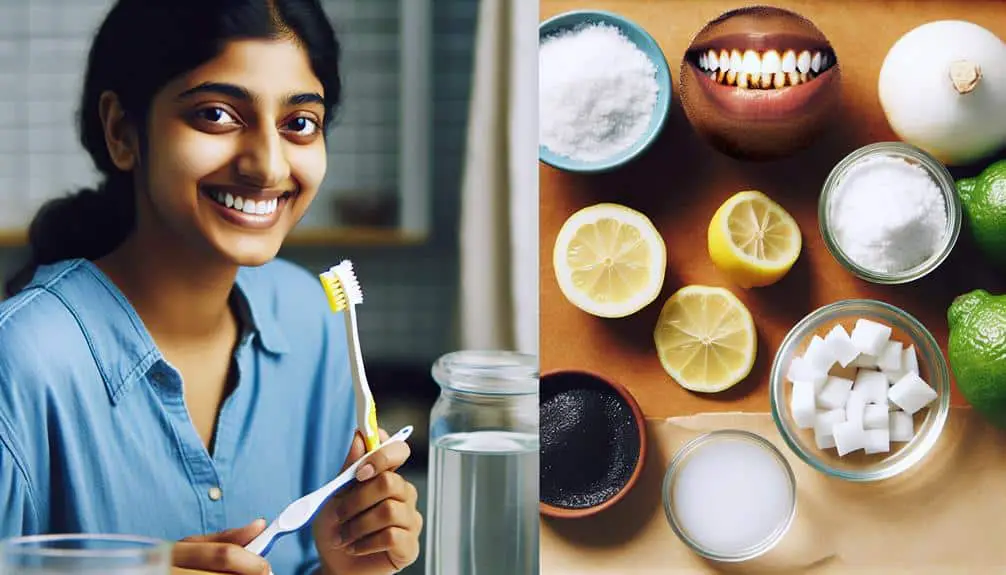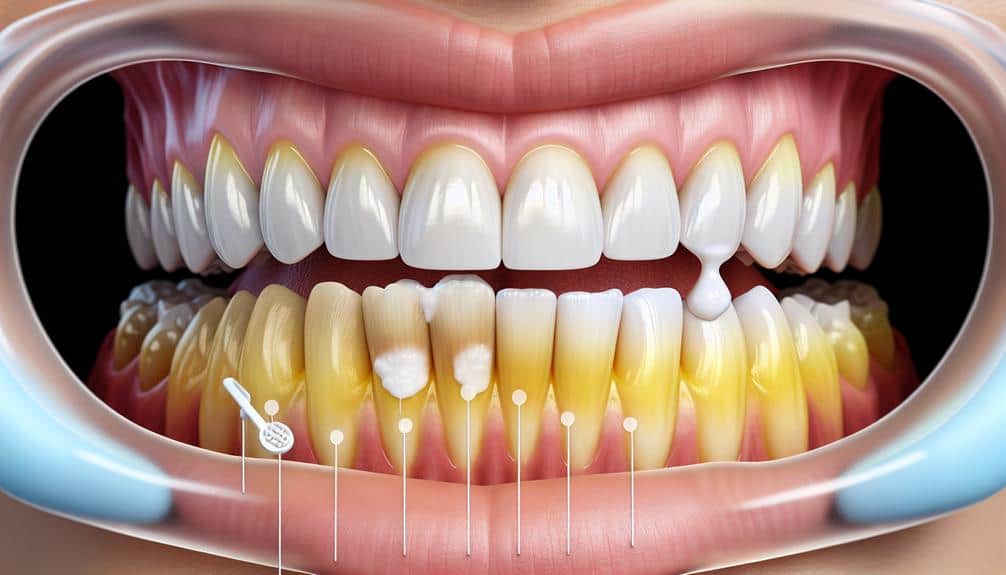To address genetic tooth discoloration, try DIY solutions like homemade baking soda and hydrogen peroxide paste or whitening strips with peroxide gels. Natural methods include oil pulling, baking soda paste, or a mix of strawberries and baking soda for brightness. Lifestyle changes such as dietary modifications and good oral hygiene can also help. For lasting results, maintaining consistent oral care and avoiding staining substances is essential. Implement these tips for brighter smiles. More insights await on effectively managing and improving your teeth color.
Key Points
- Genetic variations impact tooth color, limiting effectiveness of DIY methods.
- Consult a dentist for personalized advice on treating genetic tooth discoloration.
- DIY approaches may not fully address underlying genetic causes of discoloration.
- Lifestyle changes can complement DIY efforts for managing tooth discoloration.
- Consider professional cosmetic dentistry for long-lasting results with genetic discoloration.
Understanding Genetic Tooth Discoloration
To understand genetic tooth discoloration, examine how specific gene variations impact the natural color of your teeth. Genetic tooth discoloration is caused by inherited gene mutations that affect the development of tooth enamel or dentin, leading to changes in tooth color. These variations can result in teeth appearing yellow, brown, or gray, regardless of oral hygiene practices.
Prevention of genetic tooth discoloration is challenging since it's primarily determined by your genetic makeup. However, maintaining good oral hygiene by brushing your teeth twice a day, flossing regularly, and visiting your dentist for routine check-ups can help prevent additional discoloration from other factors like plaque buildup or staining foods.
Understanding the underlying genetic causes of tooth discoloration can guide you in making informed decisions about potential treatment options and managing your oral health effectively. By staying proactive with your dental care, you can minimize the impact of genetic tooth discoloration on your overall oral aesthetics.
DIY Whitening Techniques at Home
Consider implementing these effective DIY whitening techniques at home to enhance the brightness of your teeth. One popular method is using a homemade paste made from baking soda and hydrogen peroxide. This mixture acts as a natural abrasive that can help remove surface stains on your teeth. Remember to use this paste sparingly to avoid damaging your enamel.
Another DIY whitening option is using DIY strips. These strips are typically coated with a whitening gel containing ingredients like carbamide peroxide or hydrogen peroxide. When applied to the teeth for a specified amount of time, these strips can help lighten the color of your teeth. Following the instructions carefully is crucial to prevent any potential side effects such as gum irritation.
Natural Remedies for Brighter Teeth
Enhance the brightness of your teeth using natural remedies for a brighter smile. Incorporating herbal remedies and making dietary changes can greatly impact the color of your teeth. Consider the following tips to improve the whiteness of your teeth:
- Oil Pulling: Swishing coconut or sesame oil in your mouth for about 15-20 minutes each day may help reduce bacteria and promote whiter teeth.
- Baking Soda Paste: Mixing baking soda with a small amount of water to create a paste can act as a gentle abrasive to remove surface stains on teeth.
- Strawberries: The malic acid in strawberries can help remove discoloration on teeth. Simply mash a strawberry and mix it with baking soda to create a natural whitening paste.
- Green Tea: Drinking green tea regularly not only promotes overall health but also contains catechins that can help fight bacteria and improve the brightness of teeth.
Lifestyle Changes for Whiter Smiles
Making adjustments to your daily habits can play a significant role in achieving whiter smiles. When aiming for a brighter smile, consider implementing dietary modifications that promote dental health. Avoid foods and beverages known to cause staining, such as coffee, tea, and red wine. Opt for a diet rich in crunchy fruits and vegetables like apples and carrots, which can help naturally clean teeth.
Maintaining excellent oral hygiene is essential for achieving and preserving a white smile. Brush your teeth at least twice a day with a fluoride toothpaste and floss daily to remove plaque and prevent discoloration. Consider using whitening toothpaste or mouthwash to help combat surface stains.
For more dramatic results, you may explore cosmetic dentistry options or professional treatments. Cosmetic dentistry procedures like teeth whitening or veneers can provide long-lasting solutions for tooth discoloration that may not be fully addressed by lifestyle changes alone. Consult with a dentist to determine the most suitable professional treatment for your specific needs.
Precautions and Tips for Lasting Results
To maintain lasting results in achieving and preserving a white smile, it's important to adhere to specific precautions and tips for long-term success. When aiming for a radiant smile, implementing protective measures and long-term maintenance strategies is vital. Here are some expert tips to help you achieve enduring results:
- Consistent Oral Hygiene: Brush your teeth twice a day and floss regularly to prevent new stains from forming.
- Regular Dental Check-ups: Schedule routine dental visits for professional cleanings and to address any emerging issues promptly.
- Avoid Staining Substances: Limit consumption of dark-colored beverages like coffee and tea, and avoid smoking to prevent tooth discoloration.
- Use Whitening Products Wisely: If using at-home whitening kits, follow instructions carefully to prevent damage to your teeth and gums.
Frequently Asked Questions
Can Genetic Tooth Discoloration Be Completely Reversed With DIY Solutions?
Genetic tooth discoloration isn't entirely reversible with DIY solutions. While some improvement may occur, professional intervention often yields better results due to the limited whitening efficacy of at-home remedies compared to treatments available through dental experts.
Are There Any Specific DIY Whitening Techniques That Work Better for Genetic Tooth Discoloration?
For genetic tooth discoloration, some DIY whitening alternatives may show promise. Natural remedies like baking soda and hydrogen peroxide have shown effectiveness, but consult a dental professional for the best approach.
How Long Does It Typically Take to See Results From Natural Remedies for Genetic Tooth Discoloration?
Pearly whites won't appear overnight. Patience is key when trying natural remedies for genetic tooth discoloration. Results vary, but noticeable changes typically take a few weeks to a couple of months. Consistent use enhances effectiveness.
Can Lifestyle Changes Alone Significantly Improve Genetic Tooth Discoloration?
Making lifestyle adjustments like dietary changes can help lessen genetic tooth discoloration. However, for significant improvement, professional treatments such as those offered in cosmetic dentistry may be required to achieve desired results efficiently.
Are There Any Long-Term Risks or Side Effects Associated With DIY Solutions for Genetic Tooth Discoloration?
When contemplating DIY solutions for genetic tooth discoloration, it's important to conduct a thorough risk assessment. Long-term effects and safety concerns may arise from improper use of DIY treatments, potentially leading to adverse outcomes.



